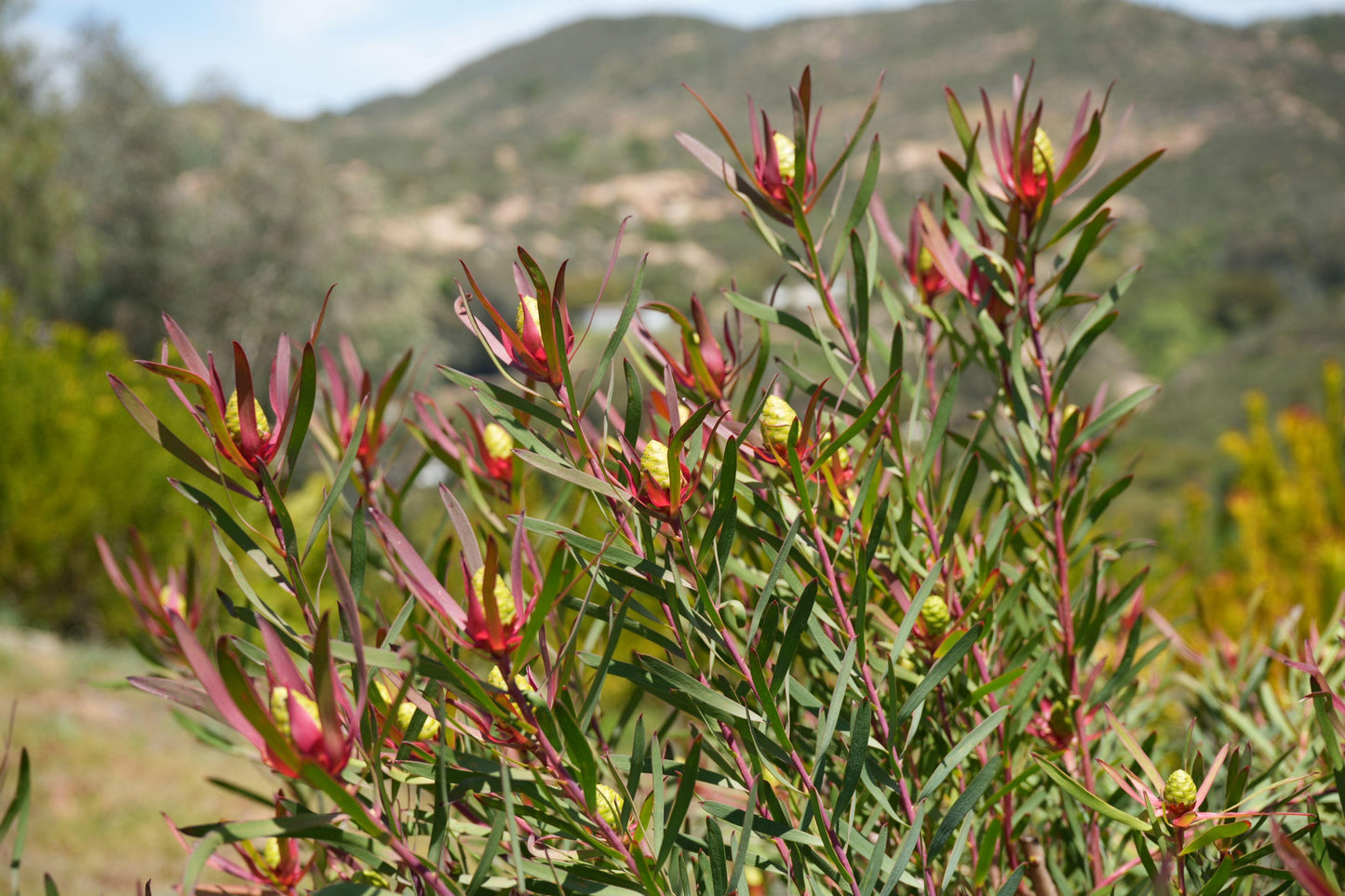Bonte Farm
Leucadendron 'Gypsy Red': Ignite Your Garden with Vibrant Crimson Elegance
Leucadendron 'Gypsy Red': Ignite Your Garden with Vibrant Crimson Elegance
Couldn't load pickup availability
💃 Leucadendron 'Gypsy Red': The Ruby-Tipped Conebush
The Leucadendron 'Gypsy Red' is an eye-catching and reliable Conebush hybrid (Leucadendron genus) celebrated for its vibrant cool-season coloration and consistent display.1 This spectacular evergreen shrub is a popular choice for adding year-round structure and intense color to the garden.2 It is primarily grown for its foliage, where the new growth and the terminal leaves/bracts surrounding the cones turn a striking ruby-red or deep pink hue, especially when nights are cool. 'Gypsy Red' is an excellent, medium-sized specimen plant for creating a lively focal point and vibrant contrast in Mediterranean, coastal, and xeriscape gardens.3 Its robust, naturally bushy habit, superior drought tolerance, and consistent color make it a resilient and low-maintenance choice, yielding superb, long-lasting cut foliage and cones.
Botanical Characteristics
|
Characteristic |
Detail |
|
Scientific Name |
Leucadendron 'Gypsy Red' (Hybrid Cultivar) |
|
Common Names |
Gypsy Red Conebush, Red-Tipped Leucadendron. |
|
Growth Habit |
A sturdy, mounding evergreen shrub with a dense, rounded, and naturally bushy habit, ideal for borders. |
|
Foliage |
Features slender, green leaves with the tips and terminal bracts turning an intense ruby-red to deep pink in the cooler months. |
|
Flowers/Cones |
Inconspicuous flowers surrounded by showy, colorful terminal leaves (bracts) that hold the peak red coloration. |
|
Flowering Season |
Color peaks dramatically from late autumn through early spring, providing essential cool-season radiance. |
|
Cut Flower Use |
Premier professional-grade cut foliage, highly valued for its strong stems, bright red tips, and multi-season appeal. |
Mature Size
'Gypsy Red' is a moderate-sized shrub that is excellent for use in the foreground or middle of a border.4
- Height: Typically reaches 5–7 feet (1.5–2.1 meters) tall.
- Spread: Achieves a dense, manageable spread of 4–6 feet (1.2–1.8 meters) wide.
- Its size is perfect for creating a bright, structural focal point.
USDA Hardiness Zone
This Leucadendron hybrid is best suited for USDA Hardiness Zones 9–11. It requires a mild, nearly frost-free climate and thrives in full sun, performing exceptionally well in sunny, dry-summer regions. It is intolerant of sustained freezing temperatures.
Cultivation and Care
|
Aspect |
Care Instructions |
|
Sunlight |
Requires full sun (a minimum of 6 hours of direct sun daily) to ensure the richest ruby-red color and excellent air circulation. |
|
Soil |
Essential: Demands perfectly well-drained, acidic soil (pH 5.0–6.0). Thrives in sandy, gritty, low-nutrient soils and must not sit in heavy, wet clay. |
|
Water |
Highly drought-tolerant once established. Water deeply during the first year. Mature plants require minimal summer water; overwatering is the primary threat. |
|
Fertilizer |
Crucial: ABSOLUTELY AVOID all phosphorus fertilizers. Proteaceae are extremely phosphorus-sensitive. Use a specialized, low-phosphorus formula or skip fertilizing entirely. |
|
Pruning |
Mandatory: Prune lightly after the color display fades, cutting back to maintain a dense, bushy shape and promote new colorful growth. |
Landscape Use
- Specimen Plant: Used as a highly colorful, central focal point due to its intense ruby-red hues.
- Border Plant: Excellent for providing year-round structure and cool-season color in sunny borders.
- Cut Foliage Garden: Grown specifically for its professional-grade, high-yield, long-lasting floral stems.
- Xeriscape Design: A cornerstone, low-water, low-fertility plant for arid landscapes.
Wildlife Attraction
The dense, mounding habit of the shrub provides valuable shelter and nesting sites for native birds in the garden, contributing to garden biodiversity.
Pest and Disease Resistance
Leucadendron 'Gypsy Red' is generally a hardy and robust plant when its crucial drainage needs are met.5 The most common issues are root rot and collar rot, which are caused by poor soil drainage or overwatering—this is the single most critical factor to avoid.
Propagation
To ensure the resulting plant maintains the specific, desirable traits, ruby-red color, and vigorous habit of the 'Gypsy Red' cultivar, propagation must be conducted using vegetative methods. Semi-hardwood cuttings are the preferred and most reliable technique, generally taken during the warmer months. Propagation from seed is not used for maintaining cultivar identity.
Share







FAQs
Got a question? We are here to answer







